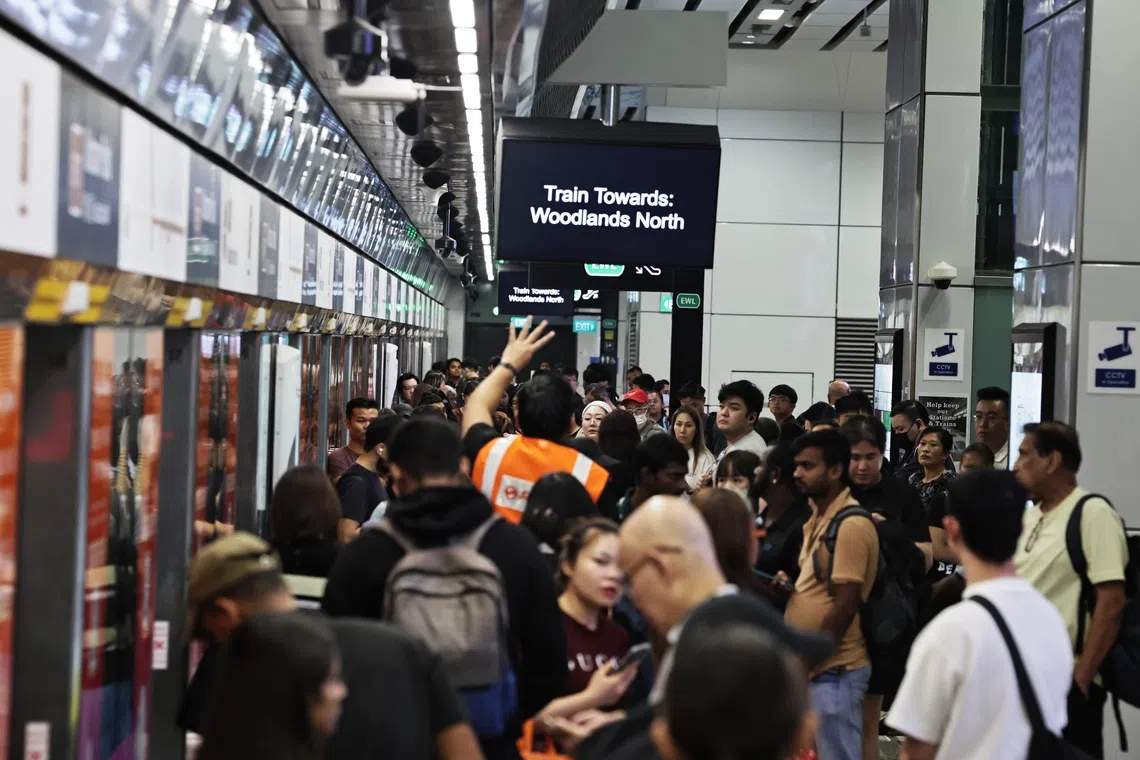Independent panel suggests longer scheduled MRT closures in S’pore to speed up rail renewal
Sign up now: Get ST's newsletters delivered to your inbox

The rail reliability task force was set up after at least 15 delays and interruptions across the MRT and LRT networks between July and September.
PHOTO: ST FILE
Follow topic:
- Rail experts advise longer planned shutdowns for Singapore's train network to enhance critical maintenance and renewals safely and efficiently.
- Implement a comprehensive condition-monitoring system for predictive maintenance; this includes upgrading skills and improving work processes.
- Improve communication during disruptions for stranded passengers, those at stations, and those outside the network, and develop engineering talent, says the independent advisory panel.
AI generated
SINGAPORE – An international panel of rail experts
“As Singapore’s network grows and ages, maintenance and renewal activities will have to pick up in pace,” Dr Tony Lee said on Nov 18. He was speaking on behalf of the five-member independent advisory panel
Renewing several critical systems simultaneously while managing day-to-day rail operations poses challenges, said Dr Lee, and the works will need to be carefully planned and spread out.
At present, available hours for such works after train services end are short, he noted. Generally, up to four hours a night are available.
Dr Lee, a former operations and innovation director at Hong Kong public transport operator MTR Corporation, is part of the panel appointed in October to advise the task force.
The task force was set up after at least 15 delays and interruptions across the MRT and LRT networks between July and September. Chaired by LTA chief executive Ng Lang, it includes the heads of rail operators SMRT and SBS Transit.
The five rail experts on the panel are in Singapore from Nov 17 to 21 to meet LTA, SMRT and SBS Transit, the three organisations said in a statement on Nov 18. It is the first time the experts have come together in Singapore.
The panel’s other immediate suggestions include rolling out a comprehensive condition-monitoring system across the rail network to allow operators to better carry out predictive maintenance.
Predictive maintenance is a strategy that uses data to predict when equipment might fail, allowing maintenance to be scheduled before a breakdown occurs.
But rolling out such a system across the entire rail network will take several years, Dr Lee noted, along with the need to upgrade workers’ skills and improve work processes.
He added that the task force is also exploring new tools, such as digital systems, artificial intelligence and automation, to manage rail systems and fix problems before they happen.
“It is also worth investing in simulation systems to test scenarios and mitigate situations early,” said Dr Lee.
The panel also advised LTA and the rail operators to build a pipeline of engineering crew in the rail sector.
Dr Lee suggested that system designers should gain front-line operational experience, while front-line operators should build up knowledge in system design and the management of assets.
“Rail operators must continue to develop the engineering agility to manage day-to-day challenges,” he added.
The task force has also advised the rail operators to better communicate with three distinct groups when a disruption happens. These groups are passengers stranded in trains, passengers in affected stations, and those outside the rail network who might be considering travel on the affected service.
The independent advisory panel’s findings and recommendations will contribute to the task force’s efforts to boost rail reliability and passenger experience across the rail network, LTA, SMRT and SBS Transit said.
The panel, they added, will advise the task force and review its findings so far. While these findings were not disclosed, LTA said they will be made known in the task force’s final report.
Dr Lee said the task force is “taking steps in the right direction” by reviewing areas such as asset renewal, communicating with passengers during disruptions, and leveraging technology to monitor core rail systems such as signalling and power supply.
While in Singapore, the panel will also visit rail facilities to review how they currently operate, maintain their systems, integrate different technologies and work to improve reliability across the network. It also plans to look at how they respond to incidents, and to review their organisations’ skills and capabilities.
“Singapore’s rail system operates at high reliability standards by international benchmarks. Keeping these standards up is a constant endeavour as systems and components wear and tear, and ridership grows,” Dr Lee said.
The other members of the panel are Mr Patrick Bauchart, former vice-president for urban rail signalling in Asia at French signalling system provider Thales; Dr Cai Chang Jun, former deputy general manager of the Guangzhou Metro Group; Professor Tsay Huel-Sheng, former chairman and president of the Taipei Rapid Transit Corporation; and Mr Kon Shinichiro, managing executive officer of Meidensha Corporation Japan, which provides power supply systems for Japan’s high-speed rail and metro system.
The task force’s report will be submitted to Acting Transport Minister Jeffrey Siow by the end of 2025.


